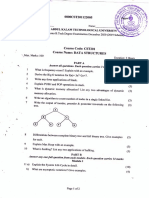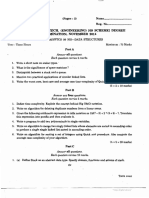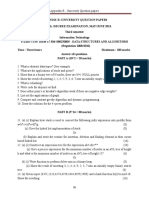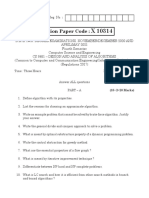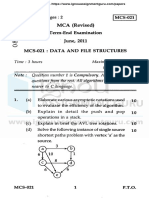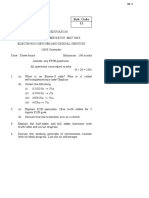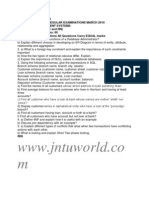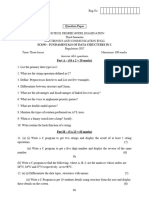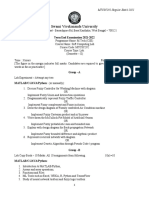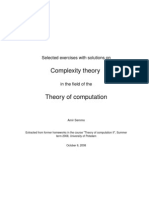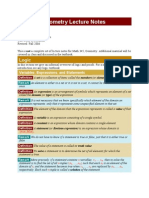1 CS205 - DATA - STRUCTURES - QP MAIN JAN 2017 - Ktu Qbank
1 CS205 - DATA - STRUCTURES - QP MAIN JAN 2017 - Ktu Qbank
Uploaded by
jeenaCopyright:
Available Formats
1 CS205 - DATA - STRUCTURES - QP MAIN JAN 2017 - Ktu Qbank
1 CS205 - DATA - STRUCTURES - QP MAIN JAN 2017 - Ktu Qbank
Uploaded by
jeenaOriginal Title
Copyright
Available Formats
Share this document
Did you find this document useful?
Is this content inappropriate?
Copyright:
Available Formats
1 CS205 - DATA - STRUCTURES - QP MAIN JAN 2017 - Ktu Qbank
1 CS205 - DATA - STRUCTURES - QP MAIN JAN 2017 - Ktu Qbank
Uploaded by
jeenaCopyright:
Available Formats
D B3D041 Total Pages:3
Reg. No. Name:
APJ ABDUL KALAM TECHNOLOGICAL UNIVERSITY
THIRD SEMESTER B.TECH DEGREE EXAMINATION, JANUARY 2017
Course Code: CS 205
Course Name: DATA STRUCTURES (CS, IT)
Max. Marks:100 Duration: 3 Hours
PART A
(Answer ALL Questions)
1. Compare and contrast singly linked list and doubly linked list. (3)
2. What do you understand by complexity of an algorithm? Write worst case and best case
complexity of linear search. (3)
3. Let LIST be a singly linked list in memory. Write an algorithm to find number of times a
given data item called ITEM occurs in LIST. (3)
4. Define the terms
a) Frequency count.
b) Stepwise refinement technique. (3)
PART B
(Answer Any Two Questions)
5. Describe the different notations used to describe the asymptotic running time of an
algorithm. (9)
6. How a linked list can be used to represent a polynomial 5x3+4x2+3x+2? Give an algorithm
to perform addition of two polynomials using linked list. (9)
7. Give an algorithm to perform following operations in a singly linked list.
(a) Insert a new node after a given node. (3)
(b) Delete last node. (3)
(c) Count the number of elements in the list. (3)
Page 1 of 3
For More Visit : KtuQbank.com
D B3D041 Total Pages:3
PART C
(Answer ALL Questions)
8. What is a circular queue? How it is different from normal queue? (3)
9. Free memory blocks of size 60K, 25K, 12K, 20K, 35K, 45K and 40K are available in this
order. Show the memory allocation for a sequence of job requests of size 22K, 10K, 42K,
and 31K (in this order) in First Fit, Best Fit and Worst Fit allocation strategies. (3)
10. How a stack can be implemented using linked list? (3)
11. Write an algorithm to perform concatenation of two strings. (3)
PART D
(Answer Any Two Questions)
12. Write an algorithm for evaluating a postfix expression and evaluate the following postfix
expression using the algorithm AB+CD/AD-EA˄ + * where A=2, B=7, C=9, D=3, E=5
(9)
13. List the properties of binary search tree. Write an algorithm to search an element from a
binary search tree. (9)
14. a) Write the non recursive preorder traversal algorithm. (4.5)
b) What is the output obtained after preorder, inorder and postorder traversal of the
following tree. (4.5)
7 9
3 4
2
1 6 8
PART E
(Answer Any Four Questions)
15. Write an algorithm for merge sort technique. Illustrate with an example. Give its
complexity. (10)
Page 2 of 3
For More Visit : KtuQbank.com
D B3D041 Total Pages:3
16. Give any two representations of graph. Give algorithm for DFS. Demonstrate DFS using
suitable example. (10)
17. Give an algorithm to perform binary search. Using the algorithm, search for elements 23
and 47 in the given set of elements[12 23 27 35 39 42 50]. (10)
18. a) Write algorithm for (i) Insertion sort (ii) Bubble sort (6)
b) Illustrate the insertion sort algorithm and bubble sort algorithm on input
[30,20,10,60,70,40] (4)
19. Define hashing. What are the properties of a good hash function? With necessary
examples explain four different hashing techniques. (10)
20. Define collision. What is linear probing? The following keys 10, 16, 11, 1, 3, 4,23 and 15
are inserted into an initially empty hash table of length 10 using open addressing with hash
function h(k) = k mod 10 and linear probing. What is the resultant hash table? (10)
***
VIEW OTHER QUESTION PAPERS
Page 3 of 3
For More Visit : KtuQbank.com
You might also like
- CS8391-Data Structures-Anna University Question PapersDocument8 pagesCS8391-Data Structures-Anna University Question Papersbhuvangates75% (4)
- 2020 December CST201-ADocument2 pages2020 December CST201-Ajishnusuresh308No ratings yet
- Answer All Questions, Each Carries 3 Marks: Reg No.: - NameDocument2 pagesAnswer All Questions, Each Carries 3 Marks: Reg No.: - NameMooo PointNo ratings yet
- CST201 DATA STRUCTURES, December 2020Document2 pagesCST201 DATA STRUCTURES, December 2020Anas AnsarNo ratings yet
- Cst201 Data Structures, December 2020Document2 pagesCst201 Data Structures, December 2020SHAHEEM TKNo ratings yet
- Cst201 Data Structures, December 2021Document2 pagesCst201 Data Structures, December 2021SHAHEEM TKNo ratings yet
- Cst201 Data Structures, December 2021Document2 pagesCst201 Data Structures, December 2021ArathyNo ratings yet
- CST201 Data Structures, December 2022Document3 pagesCST201 Data Structures, December 2022mynotesklNo ratings yet
- Question-Regular-Cs205 Data Structures (CS, It), December 2017Document2 pagesQuestion-Regular-Cs205 Data Structures (CS, It), December 2017For FunNo ratings yet
- Wa0018.Document3 pagesWa0018.kutz5811No ratings yet
- CST201 DATA STRUCTURES, DECEMBER 2021Document2 pagesCST201 DATA STRUCTURES, DECEMBER 2021ANUPAMA RNo ratings yet
- CST201 Data Structures, December 2021Document2 pagesCST201 Data Structures, December 2021Anas AnsarNo ratings yet
- Adobe Scan 29 May 2024Document15 pagesAdobe Scan 29 May 2024Prakruthi HS GowdaNo ratings yet
- Data Structures (CS 231)Document2 pagesData Structures (CS 231)Priyank ThakkarNo ratings yet
- Cs205-E S3dec18 KtuwebDocument2 pagesCs205-E S3dec18 KtuwebVighnesh MuralyNo ratings yet
- DSA Model QPDocument5 pagesDSA Model QPVASANTHI GNo ratings yet
- MCS-21Document54 pagesMCS-21vijay.official2050No ratings yet
- CSE203Document45 pagesCSE203Fabliha AfiaNo ratings yet
- 3 Principles of Database Design CS S4 B.tech KTU 2017Document2 pages3 Principles of Database Design CS S4 B.tech KTU 2017pradeepmadhaviNo ratings yet
- Reg 2017Document13 pagesReg 2017mithunsavio.26csbNo ratings yet
- DSDocument2 pagesDSAamina KhatoonNo ratings yet
- MCA105Document1 pageMCA105Abhi MittalNo ratings yet
- CS 09 303 Data Structures NOV 2014Document2 pagesCS 09 303 Data Structures NOV 2014Sai DasNo ratings yet
- Appendix BDocument23 pagesAppendix BVasantha KumariNo ratings yet
- dsa 2-14Document3 pagesdsa 2-14bhushanseelan786No ratings yet
- MCS 21Document3 pagesMCS 21mevishalsingh184No ratings yet
- Bachelor of Computer Application (B.C.A.) Semester-I (C.B.S.) Examination "C" Programming Paper-IIDocument2 pagesBachelor of Computer Application (B.C.A.) Semester-I (C.B.S.) Examination "C" Programming Paper-IISaurabh RautNo ratings yet
- Question Paper Code: 57236: Cseannauniv - Blogspot.inDocument3 pagesQuestion Paper Code: 57236: Cseannauniv - Blogspot.inSenthil KumarNo ratings yet
- Mca-20-12 Kuk Mca Data Structures PaperDocument3 pagesMca-20-12 Kuk Mca Data Structures PapergauravNo ratings yet
- E D1071 Pages: 4: Limit Answers To The Required Points. Answer All Questions, Each Carries 3 MarksDocument4 pagesE D1071 Pages: 4: Limit Answers To The Required Points. Answer All Questions, Each Carries 3 MarksAnandu ChickuNo ratings yet
- Nov Dec 2021Document3 pagesNov Dec 2021anithaNo ratings yet
- Question Paper Code:: (10×2 20 Marks)Document4 pagesQuestion Paper Code:: (10×2 20 Marks)Nallasivam MunnurNo ratings yet
- Subject: - : Sixth Semester B.Tech Degree Model Examination, March 2018Document30 pagesSubject: - : Sixth Semester B.Tech Degree Model Examination, March 2018Akshatha NayakNo ratings yet
- Dsa 2019Document2 pagesDsa 2019obamaamerican40No ratings yet
- WWW - Manaresults.Co - In: B) What Is Recursion? Give The Properties of A Recursive Definition of An Algorithm.Document2 pagesWWW - Manaresults.Co - In: B) What Is Recursion? Give The Properties of A Recursive Definition of An Algorithm.thirupathiNo ratings yet
- Compiler Design Question PapersDocument6 pagesCompiler Design Question PapersAkarsh DubeyNo ratings yet
- 2020 - December - UG - B.SC (CS) - B.SC (CS)Document29 pages2020 - December - UG - B.SC (CS) - B.SC (CS)Deepak's PageNo ratings yet
- MCS-021 No. of Printed Pages: 3 MCA (Revised) Term-End Examination R - June, 2012 Mcs-021: Data and File StructuresDocument3 pagesMCS-021 No. of Printed Pages: 3 MCA (Revised) Term-End Examination R - June, 2012 Mcs-021: Data and File StructuresAman PunitNo ratings yet
- MCS 021 Previous Year Question Papers by IgnouassignmentguruDocument63 pagesMCS 021 Previous Year Question Papers by IgnouassignmentguruRitika VermaNo ratings yet
- DBMS QuestionDocument57 pagesDBMS Questionexamlab57No ratings yet
- QP22P2 - 290 - 29-Mar-2022 13:28:49 - 117.55.242.131: Time: 3 Hours Total Marks: 100Document2 pagesQP22P2 - 290 - 29-Mar-2022 13:28:49 - 117.55.242.131: Time: 3 Hours Total Marks: 100reshu.tyagiNo ratings yet
- Sem 3 ECE 2022 PYQsDocument19 pagesSem 3 ECE 2022 PYQsmagicaltanya9No ratings yet
- Cs PapersDocument19 pagesCs PapersPraveen I Hiragannavar100% (1)
- Gujarat Technological UniversityDocument2 pagesGujarat Technological Universitynikita gohelNo ratings yet
- Bca - DS Nov 2020Document2 pagesBca - DS Nov 2020AdithNo ratings yet
- BCA May 2018 Question Papers PDFDocument45 pagesBCA May 2018 Question Papers PDFsakthivelNo ratings yet
- CS 8391 - Data StructuresDocument4 pagesCS 8391 - Data StructuresJeshifa G ImmanuelNo ratings yet
- Data Structures Data Structure and AlgorithmsDocument4 pagesData Structures Data Structure and Algorithmsxyz86538No ratings yet
- Data Structures 20CSC08-1Document2 pagesData Structures 20CSC08-1mallesandeepNo ratings yet
- MCS 031Document5 pagesMCS 031rajivkkNo ratings yet
- Problem Solving With C Ktu Question Paper MCA S1 DEC 208Document13 pagesProblem Solving With C Ktu Question Paper MCA S1 DEC 208AnaghaNo ratings yet
- I Semester BCA Examination (NEP - SCHEME) : Subject: Computer ScienceDocument2 pagesI Semester BCA Examination (NEP - SCHEME) : Subject: Computer Sciencechandan reddyNo ratings yet
- The Open University of Sri Lanka Faculty of Engineering Technology Department of Electrical and Computer EngineeringDocument4 pagesThe Open University of Sri Lanka Faculty of Engineering Technology Department of Electrical and Computer EngineeringYasith Ishara PereraNo ratings yet
- CS1602-Data Structures and Algorithms-Anna University-Question PapersDocument13 pagesCS1602-Data Structures and Algorithms-Anna University-Question Papersbhuvangates100% (1)
- CS464 - QPDocument2 pagesCS464 - QPanjanaanilkumar2708No ratings yet
- ND-2020-CS 8602-Compiler DesignDocument3 pagesND-2020-CS 8602-Compiler DesignvijayalakshmisNo ratings yet
- Previous PapersDocument7 pagesPrevious Paperssureshkumar_kotipalliNo ratings yet
- Mcs NotesDocument2 pagesMcs Noteskrishan dev RamNo ratings yet
- EC8393-Fundamentals of Data Strucutres in CDocument3 pagesEC8393-Fundamentals of Data Strucutres in Csyed1188No ratings yet
- Part 1 - Lambda ExpressionsDocument102 pagesPart 1 - Lambda Expressionszubes78No ratings yet
- RkCD-Chapter 4 - Syntax AnalysisDocument20 pagesRkCD-Chapter 4 - Syntax Analysiselsai eliasNo ratings yet
- TEE MTCSC292 Soft Computing LabDocument2 pagesTEE MTCSC292 Soft Computing LabEKNo ratings yet
- MA-201 Tutorial Sheet 4Document1 pageMA-201 Tutorial Sheet 4kumarisezal81No ratings yet
- Probability Theory - Year 2 Applied Maths& Physics - 2019-2020 PDFDocument126 pagesProbability Theory - Year 2 Applied Maths& Physics - 2019-2020 PDFElie UwimanaNo ratings yet
- DAA Final Examination 2005enDocument9 pagesDAA Final Examination 2005enGamindu UdayangaNo ratings yet
- PX X X X: Exercises OnDocument2 pagesPX X X X: Exercises Onيوسف الماميNo ratings yet
- Statements, Quantifier, S and NegationsDocument17 pagesStatements, Quantifier, S and NegationsOceans123No ratings yet
- Pathfinding in 3d SpaceDocument24 pagesPathfinding in 3d SpaceGiorgi RcheulishviliNo ratings yet
- DeMorgan's Theorem and LawsDocument12 pagesDeMorgan's Theorem and LawsJames MukhwanaNo ratings yet
- Functions Example 1:: G (X) Under G. X and G (X) 2x. in This Case, H A H A H A FDocument6 pagesFunctions Example 1:: G (X) Under G. X and G (X) 2x. in This Case, H A H A H A FOGEGA KERUBONo ratings yet
- Pointers ReviewDocument28 pagesPointers ReviewSello Hlabeli100% (1)
- Comp106 LogicDocument98 pagesComp106 LogicAOne ThreeONineNo ratings yet
- MCS 211Document3 pagesMCS 211Amish SinghNo ratings yet
- Algorithm Report PDFDocument6 pagesAlgorithm Report PDFWaleed KhanNo ratings yet
- Summary Reviewer in LogicDocument8 pagesSummary Reviewer in LogicMari CrisNo ratings yet
- UdfDocument14 pagesUdfkazashi25No ratings yet
- SAT: Propositional Satisfiability: A TutorialDocument37 pagesSAT: Propositional Satisfiability: A Tutorialsend_2meNo ratings yet
- Complexity Theory: Selected Exercises With Solutions OnDocument19 pagesComplexity Theory: Selected Exercises With Solutions OnpmignotNo ratings yet
- Dokumen - Tips Integer Programming Goal Programming and Nonlinear ProgrammingDocument70 pagesDokumen - Tips Integer Programming Goal Programming and Nonlinear Programmingeng.maher.osmanNo ratings yet
- DAA Lab ManualDocument39 pagesDAA Lab ManualAYUSH TRIPATHINo ratings yet
- Lec6 Constr OptDocument30 pagesLec6 Constr OptDevendraReddyPoreddyNo ratings yet
- 9-Adder CircuitDocument3 pages9-Adder CircuitJay VenturaNo ratings yet
- Lattices Have A Number of Applications, and They Provide One Way For Us ToDocument2 pagesLattices Have A Number of Applications, and They Provide One Way For Us ToRadhika RathoreNo ratings yet
- Tutorial 3 Lab 3Document4 pagesTutorial 3 Lab 3Sohar AlkindiNo ratings yet
- Here Is A Pascal Program To Solve Small Problems Using The Simplex AlgorithmDocument12 pagesHere Is A Pascal Program To Solve Small Problems Using The Simplex AlgorithmRodolfo Sergio Cruz FuentesNo ratings yet
- Binary Search Trees: Welcome To CS221: Programming & Data StructuresDocument37 pagesBinary Search Trees: Welcome To CS221: Programming & Data StructuresPRITAM RAJNo ratings yet
- Geometry Lecture Notes: LogicDocument85 pagesGeometry Lecture Notes: LogicZerihun IbrahimNo ratings yet



